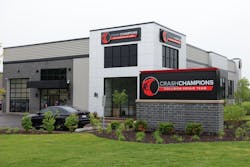SHOP STATS: Crash Champions–Bolingbrook Location: Bolingbrook, Ill. CEO and founder: Matt Ebert Average Monthly Car Count: 250, with capacity for up to 350 Staff Size: 29 Shop Size: 33,000 square feet DRPs: 19 Annual Revenue: $10 million
1. Towering Design
Crash Champions CEO Matt Ebert says the fast-growing MSO’s shop in Bolingbrook, Illinois, one of more than 200 in the network, is a flagship location.
Acquired by the company in July 2019, Ebert says Crash Champions-Bolingbrook was an existing 16,000-square-foot body shop, which was built-out to incorporate a neighboring building to get it to its current 33,000-square-feet of size.
Part of the remodel included adding Crash Champions’ distinctive tower.
“It just calls attention to the entrance, it’s very noticeable, it’s just the same as the arches are for McDonald’s,” Ebert says.
2. Open Office
The front of the shop is branded with Crash Champions’ colors and signage, and includes offices and a small waiting area for customers. Ebert says it’s “very simple and clean.”
“We keep everybody in [a single] office space–we don’t have a bunch of small offices. That keeps the group together,” says Ebert, adding that anybody at a desk can make eye contact with customers and greet them, and that the open office allows everybody, including vendors and customers, to overhear what’s going on.
“It’s helpful,” he says.
3. Shared Space
The shop’s floor is designed around a tech’s ability to move vehicles without having to interrupt others’ work, Ebert says.
The paint shop includes three Blowtherm paint booths, with a double-bay enclosed heated prep station, he says, with one booth built taller for painting Sprinter vans.
There are a couple Car-O-Liner frame racks, along with other shared tools and equipment, in the center of the shop floor, Ebert says, with generous space for parts in various areas, including a dedicated receiving door for parts orders.
Aluminum repairs aren’t needed so often as to have a dedicated space, Ebert says, so an area with a lift can be used both for mechanical work as well as for aluminum.
“You close the curtains, turn on the fans, and do the aluminum work,” he says.
4. Drive On Through
Ebert says Crash Champions’ Midwest locations include a drive-thru for intake and delivery of vehicles—it’s also a useful area for PDR work following a hailstorm, and can be used to store cars that have been washed in order to avoid having to wash them again.
“It’s nothing you need in Southern California,” he says, “but in the Midwest, where it’s raining often, and cold in the winter, it’s great.”

